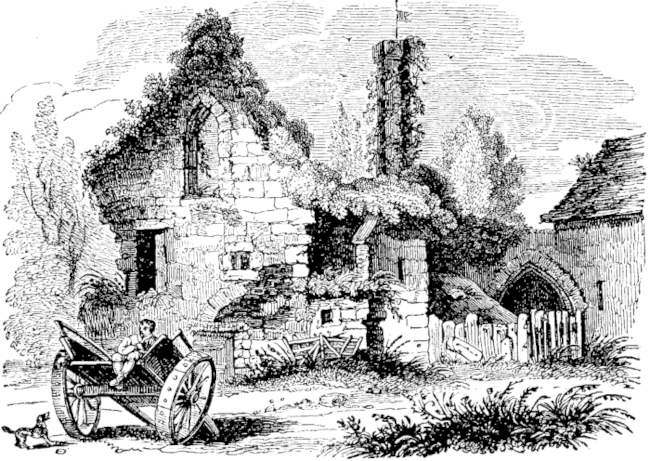[pg81]
THE MIRROR
OF
LITERATURE, AMUSEMENT, AND INSTRUCTION.
| Vol. 20. No. 561.] | SATURDAY, AUGUST 11, 1832. | [PRICE 2d. |
BURNHAM ABBEY
Burnham is a village of some consideration, in Buckinghamshire,and gives name to a deanery and hundred. Its prosperity has beenalso augmented by the privilege of holding three fairs annually. Itis situate in the picturesque vicinity of Windsor, about five milesfrom that town, and three miles N.E. of Maidenhead. It wasanciently a place of much importance. One of the few relics of itsgreatness is the ivy-mantled ruin represented in the aboveEngraving. So late as the fourteenth century, Burnham could alsoboast of a royal palace within its boundary: but, alas! the wand ofProspero has long since touched its gorgeousness, so as to “leavenot a rack behind.”
The ruin stands about one mile south of the village, and is partof an Augustine nunnery, built in the year 1228, by Richard, Earlof Cornwall, and brother of Henry the Third. He was a vexatiousthorn in the crown of Henry, whose long and confused reign, “wereit not that for the first time it exhibits the elements of theEnglish constitution in a state of disorderly fermentation, wouldscarcely deserve the consideration of the philosopher and thepolitician.”1 One of Richard’s fraternal acts wasplacing himself at the head of a formidable confederacy, to whichHenry was obliged to yield. The papal power was at this time at itsgreatest height; Richard had been elected King of the Romans, andfrom the spoil obtained by the monstrous exactions of his court, hemay be presumed to have erected the above nunnery. Of this systemof pious plunder we have many proud architectural memorials; thoughto rob with one hand, and found religious houses with the other,reminds one of the trade of a waterman—to look one way androw the other.
The nunnery was richly endowed with several of the neighbouringmanors; the remains are now used as the out-offices of an adjoiningfarm. Little can be traced of the “studious cloister,” the “storiedwindow,” or the “high embowed roof;” but the ivy climbs withparasitic fondness over its gable, or thrusts its rootlets asholdfasts into its crumbling wall. The dates of these ruins claimthe attention of the speculative antiquary. The chimney, though ofgreat age, did not of course belong to the original building; theearliest introduction of chimneys into this country being stated,(but without proof,) to be in the year 1300. The upper window, andthe arched doorway are in the early English style prevalent at thedate of the foundation; the former has the elegant lancet-shape ofthe earliest specimens.
[pg82]
A DREAM OF THE BEAUTIFUL.
“Another scene where happiness is sought!
A festive chamber with its golden hues,
Its dream-like sounds, and languishing delights.”
R. MONTGOMERY.
I stood in the light of the festive hall,
Gorgeously wrought was its pictured wa
